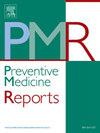Parental perceptions of child weight status and the interplay of socio-demographic factors and children's BMI in South-Western Sydney: The growing healthy kids Survey, Australia
IF 2.4
3区 医学
Q2 PUBLIC, ENVIRONMENTAL & OCCUPATIONAL HEALTH
引用次数: 0
Abstract
Objective
This paper examined parents' perceptions of their children's weight status by key parental socio-demographic factors.
Methods
We used the 2018 Growing Healthy Kids-Population Health Survey's data to analyse 1353 parents' perceptions of their child's weight status in Southwest Sydney. Generalised linear multinomial mixed models were used to determine the associations between socio-demographic and economic factors and parents' perceptions of their children's weight status.
Results
About 23 % of healthy-weight children, 65 % of overweight children and 55 % of obese children were incorrectly perceived by parents. Father as the primary guardian (overweight: OR = 0.60, 95 % CI = 0.55–0.65; obese: OR = 0.46, 95 % CI = 0.43–0.50) and parents who completed ≤12 years of school education (overweight children: OR = 0.18, 95 % CI = 0.17–0.20; obese: children OR = 0.54, 95 % CI = 0.49–0.459) were less likely to perceive their overweight or obese children as overweight although they were overweight. Parents who lived in more disadvantaged areas were more likely to perceive their obese children as obese (OR = 1.65, 95 % CI = 1.46–1.86). Parents who lived in moderately disadvantaged areas (OR = 0.54, 95 % CI = 0.47–0.61) and parents who reported an annual household income between $52,000 and $ 103,999 were less likely to perceive their overweight children as overweight (OR = 0.72, 95 % CI = 0.65–0.80; $78,000–$103,999: OR = 0.74, 95 % CI = 0.66–0.82).
Conclusion
Our findings suggest that public health interventions should involve fathers while educating families and children in most and moderately disadvantaged areas about healthy weight management. They should also integrate routine weight and height measurements at the population and clinical levels to help parents understand their child's weight status accurately.
悉尼西南地区父母对儿童体重状况的看法以及社会人口因素与儿童BMI的相互作用:成长中的健康儿童调查,澳大利亚
目的探讨父母对子女体重状况的认知,并结合主要的社会人口因素进行分析。方法我们使用2018年成长健康儿童人口健康调查的数据来分析悉尼西南部1353名父母对孩子体重状况的看法。使用广义线性多项混合模型来确定社会人口和经济因素与父母对子女体重状况的看法之间的关系。结果约23%的正常体重儿童、65%的超重儿童和55%的肥胖儿童被父母错误地认知。父亲是主要监护人(超重:OR = 0.60, 95% CI = 0.55-0.65;肥胖:OR = 0.46, 95% CI = 0.43-0.50)和完成≤12年学校教育的父母(超重儿童:OR = 0.18, 95% CI = 0.17-0.20;肥胖:儿童OR = 0.54, 95% CI = 0.49-0.459)不太可能认为自己超重或肥胖儿童超重,尽管他们超重。生活在更贫困地区的父母更有可能认为他们的肥胖儿童肥胖(OR = 1.65, 95% CI = 1.46-1.86)。生活在中等贫困地区的父母(OR = 0.54, 95% CI = 0.47-0.61)和家庭年收入在52,000美元至103,999美元之间的父母不太可能认为他们超重的孩子超重(OR = 0.72, 95% CI = 0.65-0.80;78000 - 103999美元:OR = 0.74, 95% CI -0.82 = 0.66)。结论公共卫生干预应包括父亲的参与,同时对大多数和中等贫困地区的家庭和儿童进行健康体重管理教育。他们还应该结合人群和临床水平的常规体重和身高测量,以帮助父母准确了解孩子的体重状况。
本文章由计算机程序翻译,如有差异,请以英文原文为准。
求助全文
约1分钟内获得全文
求助全文
来源期刊

Preventive Medicine Reports
Medicine-Public Health, Environmental and Occupational Health
CiteScore
3.90
自引率
0.00%
发文量
353
 求助内容:
求助内容: 应助结果提醒方式:
应助结果提醒方式:


